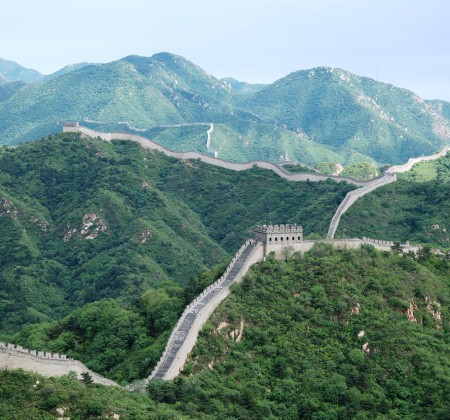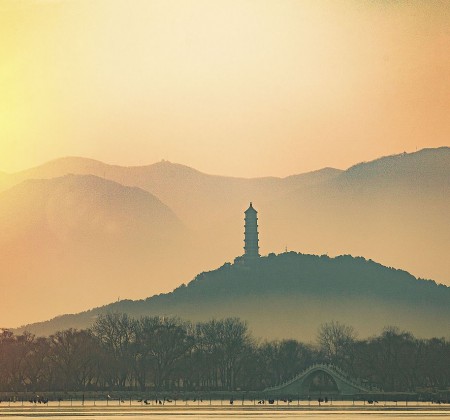Badaling Great Wall in Beijing
The construction of the Great Wall was gradually completed in the long historical years, and it took more than two thousand years from the beginning of the construction to the final completion. In human history, no building can span more than two thousand years and a hundred thousand miles of time and space like the Great Wall.
Luo Zhe-wen, a famous Great Wall scientist, uses beautiful poems to describe the history of the Great Wall as follows:
“it has lasted for more than two thousand years since the Spring and Autumn period, the Qin and Han dynasties, the Liao, Jin, and the Yuan and Ming dynasties. How many Shuai Yuanrong, Guard Li Cheng and Baigong Qianshou have made every effort to move mountains to build this great project. Strong perseverance, wisdom, hard work and hard work have left a monument and national treasure for China. ”
Few people do not know the story of Qin Shihuang’s construction of the Great Wall, because it is a historical fact.
Although he was not the one who built the Great Wall in the first place, Qin Shihuang, as an emperor through the ages, did use the strength of the whole country to build a great wall stretching thousands of miles in the north of the vast territory. Since then, the Great Wall, as a symbol of Qin Shihuang, has been deeply engraved in the annals of five thousand years of Chinese civilization.
As a symbol of the Chinese nation, the Great Wall has been established in the national character since then. No matter the stars change, regardless of the end of time, “under heaven, above the earth, at the foot of the Great Wall is the hometown”, it has become a folk song that the Chinese nation can no longer forget, reverberating forever in the hearts of every Chinese people.
Since it was not Qin Shihuang who built the Great Wall in the first place, when was the earliest Great Wall built at Badaling?
In the Spring and Autumn and warring States period before Qin Shihuang, due to the frequent, fierce and continuous expansion of the war, the military city-building technology developed widely. In order to guard against sudden attacks from neighboring countries, the vassal states built some garrison, fortress, pavilion, barrier and other guard facilities at the border, and later further connected the gates, fortresses, pavilions and barriers with city walls to expand, resulting in the emergence of the early military defense project-the Great Wall. In the late warring States period, Xiongnu, Shanrong and other nomadic tribes became more and more powerful, constantly moving south to harass and plunder. Qin, Zhao and Yan built a huge border Great Wall to guard against the harassment of nomadic tribes.
Badaling became a military strategic location, which can be traced back to the Spring and Autumn and warring States period. Badaling is located in the north of Yan, under the jurisdiction of Shanggu County, which gets its name because it was built on top of the valley. According to Chunqiu Zuo Zhuan and Historical Records, Yan, one of the seven heroes of the warring States, built military defense facilities in the Badaling area.
At that time, an important tribe of Shanrong, an ethnic minority in the north, lived in the Mianchuan Basin at the northern foot of Jundu Mountain for more than 300 years. Shanrong continued to cross Guangou south to invade Yan. When Shanrong attacked Yan again in 663 BC, Duke Huan of Qi personally led an army to conquer Shanrong and rescue Yan.
In 295 BC, King Yan Zhao built the Great Wall from Zaiyang (now Huailai Great City) to Xiangping (present-day Liaoyang County, Liaoning Province) to prevent Shanrong tribes from invading. This is the earliest Great Wall built in Badaling area-Yan Great Wall. From Zuoyang to the Yan Great Wall in eastern Liaoning, it passes through the Jundu Mountains. Cultural relics workers in Beijing found that the ruins of the remnant walls and piers of the Yan Great Wall stretching for dozens of miles from west to northeast are found in the areas of Xipizi and Yingchengzi around Badaling.
In 221 BC, Qin Shihuang annexed the six Kingdoms, ending the dispute among princes in the warring States period and accomplishing the great cause of the first feudal centralized state in Chinese history. In order to defend against the invasion of the Xiongnu tribes in the north and strengthen the protection of the border, Qin Shihuang sent Senior General Meng Tian and the Prince to help Su, commanding 300000 troops and hundreds of thousands of men, and spent nine years on the basis of the Great Wall in the border areas of Qin, Zhao and Yan. Large-scale construction, connection and addition, completed the construction of the military defense project, this is the Great Wall of the Qin Dynasty in Chinese history.
Juyongguan is famous, so where does the name “Juyong” come from?
It is said that when Qin Shihuang built the Great Wall, he migrated hundreds of thousands of men, prisoners and prisoners from the south and settled them in the Mengchuan Basin in Jundu Mountain, known as the “mediocre residence”. During the Spring and Autumn and warring States period, Juyongguan was one of the “nine fortresses in the world”.
According to the Han Shu written by Ban Gu in the Han Dynasty, in 128 BC, Emperor Wu of the Han Dynasty placed Mengchuan in Juyong County, which is now located in Yanqing, with two passes of military capital and Juyong.
The landform and landscape flow of the pass site recorded in Shuijing Notes are the same as the geographical environment of Badaling. Therefore, some Great Wall scholars and archaeologists believe that the site of Han Juyongguan should be located at Badaling.
In the Northern Wei Dynasty 1500 years ago, the Great Wall was built around Badaling. According to the records of Wei Shu-Shizu Benji, in the seventh year of Taiping Zhenjun of the Northern Wei Dynasty (AD 446), the Great Wall was built to the north of the national capital Pingcheng (present-day Datong), called “Ji Shangshang Saiwei”, from Shanggu Jundu Mountain in the east to the bank of the Yellow River in the west. The Northern Qi Dynasty Tianbao six years (555), and built the Great Wall, from Datong in the west, through the Jundu Mountain to the east, extending the Great Wall to the seaside.
Why is the Badaling Great Wall the quintessence of the Great Wall and an outstanding representative of its architecture?
The Ming Dynasty was the heyday in the history of the construction of the Great Wall. In various dynasties, the Ming Great Wall was built for the longest time, the largest scale, the highest quality and the most exquisite architecture. It is nearly ten thousand miles from Hushan in Liaoning Province in the east, Shanhaiguan through Shanhaiguan to Jiayuguan in the west, so it is called the Great Wall. The lot represented by Badaling, with complex engineering and rich shapes, is the architectural model of the Great Wall of China.
The Ming Dynasty had millions of soldiers along the Great Wall. it divided the Great Wall into nine defense zones from east to west, which were called “towns”. Each town sent general troops to take charge of the town. Beijing area belongs to thistle town. As a military unit, Badaling is a subordinate Guancheng of Juyongguan, Changzhen, which is located at the north entrance of the throat road leading to the capital, and is the forward position of Juyongguan.
Due to the important strategic position of Badaling, which is a key area for the construction of the Great Wall, the Ming Dynasty has operated it for more than 80 years, making the Badaling Great Wall a deep military defense system with city passes connected, piers and fortresses facing each other, heavy city guards and beacon beacons early warning. The majestic and sturdy Badaling Great Wall finally formed a strong military defense line in the north of Beijing from east to west.
The Badaling Great Wall is located in dangerous places. The walls are mostly built in high mountains and deep valleys. The walls are built with giant granite strips of stone and green bricks. The walls are tall and strong, and the walls are composed of city platforms, walls and enemy towers. On Badaling, the towering enemy building, magnificent momentum, magnificent and unrestrained, is the ultimate and essence of the Great Wall.
Badaling is the witness of many important events in history.









